

 中文摘要:
中文摘要:
基于微观仿真软件PARAMICS的城市车辆诱导系统与交通信号控制协同优化流程,提出了基于大规模仿真实验的最优协同策略.通过对PARAMICS进行二次开发,基于固定式信号控制、感应式信号控制以及区域联动信号控制3种信号控制策略,结合用户遵从度和诱导信息发布频次,设计13种不同诱导策略.研究共计完成仿真实验7 800次,根据仿真数据建立平均路段占有率-系统总行程时间回归模型,进而得到不同交通需求条件下最优协同策略.结果显示,不同信号控制下该最优协同策略降低总行程时间0-23.14%.同时可移植性测试显示,在可移植性测试路网中最优协同策略较基础方案降低总行程时间0-10.67%,与最优策略总行程时间差异小于3.5%,因此该最优协同策略具有较好的可移植.
 英文摘要:
英文摘要:
An optimal framework of combined traffic vehicle routing and traffic signal control schemes was developed using a microscopic simulation software PARAMICS. And simulation-based optimal integration schemes were proposed. Based on the secondary development of PARAMICS,13 different vehicle routing strategies were designed,considering three typical signal control strategies,including the fixed signal control,the actuated signal control,and the regional coordinative signal control,differing user compliance rate and route guidance information updating frequency. The results of 7 800 simulation runs were recorded. Regression models were proposed to estimate the system total travel time on various average link occupancy rates. The optimal integration schemes for different traffic conditions were then obtained. The results showthat the optimal schemes can reduce the total travel time from 0 to 23. 14% considering different traffic demands and traffic signal control strategies. Furthermore,the results of the transferability test showthat,compared with the base scheme,the proposed optimal integration schemes reduced the total travel time from 0 to 10. 67%,and the difference between the optimal integration scheme and the best scheme in the newnetwork is no more than 3. 5%. It indicates that the transferability of the proposed optimal schemes can be confirmed.
 同期刊论文项目
同期刊论文项目
 同项目期刊论文
同项目期刊论文
 期刊信息
期刊信息
